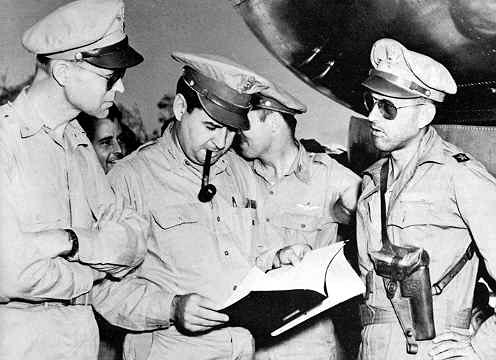Gen. LeMay took over with a vengeance, striking the Okayama aircraft complex on Formosa with 130 B-29s. On Oct. 25 he launched an attack against a factory at Omura on Kyoshu. 59 planes reached the target causing considerable damage. The XX Bomber Command continued their air strikes against airfields on Formosa, factories in Mukden, Manchuria, and Omura, Japan. From India the B-29s hit targets in Burma, Bangkok, Saigon, Camranh Bay, Pnompenh, Kuala Lumpur, and Singapore.
Gen. Arnold was overjoyed when American forces, after a fierce struggle, took over the Mariana Islands late in 1944. Bases were being constructed on Saipan, Tinian, and Guam. By Nov. over 100 planes were stationed on Saipan.
It was only a matter of time before hundreds of B-29s would be reaching all of Japan as the airfields on the Mariana Islands were completed. Guam in 1945 became a superbase. Japanese defenses were considerably better than expected. Antiaircraft fire was fairly accurate, fighter pilots were very aggressive, willing to ram the B-29s. The flights were long, with many planes running out of fuel and ditching. Damaged aircraft had priority in landing, with sometimes hundreds of planes stacked up behind them, all running on empty.
 GEN. NORSTAD, GEN. LeMay,[center] GEN. POWER ctsy Wide World |
The B-29s kept coming. On Oct. 19, 1944, the 8,500 ft. runway was completed on Saipan. Gen. "Rosey" O'Donnell took command of the 73rd Wing. Prime targets in Japan were to be aircraft factories and oil refineries.
The American Generals who were planning the attacks could never have known that their
biggest problem would be the weather over Japan. The changing winds were unpredictable, particularly
around the Mt. Fuji area.
Heavy winds pushed the planes in different directions, some obtaining a ground speed of 450 MPH. Winds
of over 150 MPH played havoc with the bombardier. The jet stream repeatedly created unexpected and unacceptable
results.The B-29s were flying at altitudes of 25,000 to 30,000 ft. to put them above antiaircraft fire
and fighter attacks. The Japanese fighter was not capable of reaching such altitudes. However the jet
stream was a problem they could not live with.
Gen. Arnold selected Gen. Haywood Hansell Jr. to run the XXI Bomber Command. He had been Gen. Arnolds Chief of Staff for the 20th Air Force, in charge of all B-29 operations. A conflict was in the making, as Hansell resented what he considered a change of policy in Washimgton. Gen. Norstad, who replaced Hansell as Chief of Staff for the 20th AF, wanted him to run a test mission with 100 planes dropping incendiaries on Nagoya. So the line was drawn. Hansell wanted only precision bombing, Norstad was an advocate for area bombing. Another controversy arose when Gen. Arnold notified Hansell that the loss rate of the B-29s was unacceptable. Hansell defended the losses. By the end of 1944 the results of the bombing raids were considered ineffective. On Jan. 3, 1945, Hansell finally conceded to Norstad and sent 97 B-29s to fire bomb Nagoya. Only 57 reached the target and the incendiaries dropped from 30,000 ft. only burned out an area the size of three football fields. Five B-29s were lost. Hansell had met Gen Norstads demand for an incendiary test, but his job was coming to an end. On Jan. 6, Gen. Norstad personally arrived on Guam to tell Hansell that Curtis LeMay would replace him. Losses under Hansell had been severe and could not continue. Hansells last flight proved successful. His flight of 62 planes hit the Kawasaki aircraft factory from 25,000 ft, cutting production by 90 percent without a single loss. LeMay took over, and was plagued with the same problems that caused Hansell to loose his job. Bad weather, the jet stream, and swarms of fighters continued.
Norstad renewed his request for the firebombing of Kobe, Japans most important shipyard city. On Feb. 4, LeMay sent 129 B-29s carrying a mixture of incendiaries and fragmentation bombs. Kobe was partially obscured by clouds, and only half of the planes found the target. Still, results were impressive. Japanese fighters shot down one B-29 and damaged 35. Six days later 84 B-29s bombed the Nakajima aircraft plant. Results were poor, only seven incendiaries hit the factory area, 97 G.P. bombs fell in the factory area but 43 were duds. It seemed LeMay was not accomplishing any more than Hansell. It was time to take Iwo Jima so the B-29s could have an emergency landing area. The cost was enormous. 7000 U.S. Marines were killed and over 19,000 wounded.